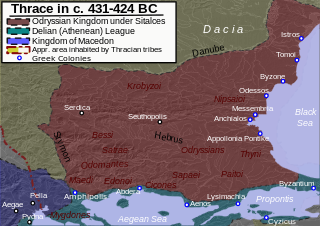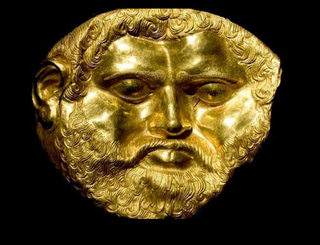
Thrace is a geographical and historical region in Southeast Europe, now split between Bulgaria, Greece and Turkey, which is bounded by the Balkan Mountains to the north, the Aegean Sea to the south and the Black Sea to the east. It comprises southeastern Bulgaria, northeastern Greece and the European part of Turkey.

In antiquity, Paeonia or Paionia was the land and kingdom of the Paeonians (Παίονες).

The Odrysian Kingdom was a state union of over 40 Thracian tribes and 22 kingdoms that existed between the 5th century BC and the 1st century AD. It consisted mainly of present-day Bulgaria, spreading to parts of Southeastern Romania, parts of Northern Greece and parts of modern-day European Turkey.

The Getae, , or Gets were several Thracian tribes that once inhabited the regions to either side of the Lower Danube, in what is today northern Bulgaria and southern Romania. Both the singular form Get and plural Getae may be derived from a Greek exonym: the area was the hinterland of Greek colonies on the Black Sea coast, bringing the Getae into contact with the ancient Greeks from an early date. Several scholars, especially in the Romanian historiography, posit the identity between the Getae and their westward neighbours, the Dacians.

Teres I, was the first king of the Odrysian state of Thrace. Thrace had nominally been part of the Persian empire since 516 BC during the rule of Darius the Great, and was re-subjugated by Mardonius in 492 BC.

The Bessi were an independent Thracian tribe who lived in a territory ranging from Moesia to Mount Rhodope in southern Thrace, but are often mentioned as dwelling about Haemus, the mountain range that separates Moesia from Thrace and from Mount Rhodope to the northern part of Hebrus. Herodotus described them as a sort of priestly-caste among the Satrae, the Bessi being interpreters of the prophetic utterances given by a priestess in an oracular shrine of Dionysus located on a mountain-top.
The Moesi was a Thracian tribe which inhabited present day Northern Bulgaria and Serbia, which gave its name to the Roman province of Moesia after its defeat in 29 BC. Moesia was first established as a separate province in 45–46 AD.
Thraco-Illyrian is a hypothesis that the Thraco-Dacian and Illyrian languages comprise a distinct branch of Indo-European. Thraco-Illyrian is also used as a term merely implying a Thracian-Illyrian interference, mixture or sprachbund, or as a shorthand way of saying that it is not determined whether a subject is to be considered as pertaining to Thracian or Illyrian. Downgraded to a geo-linguistic concept, these languages are referred to as Paleo-Balkan.

Beglik Tash, is a prehistoric rock sanctuary situated on the southern Black Sea coast of Bulgaria, a few kilometers north of the city of Primorsko. It was re-used by the Thracian tribes in the Iron Age.
The Thunatae were a Romanized Thraco-Illyrian tribe of Dardania alongside the Galabri. The Thracian Maedi tribe borders the Thunatae eastwards.

The history of Thracian warfare spans from the 10th century BC up to the 1st century AD in the region defined by Ancient Greek and Latin historians as Thrace. It concerns the armed conflicts of the Thracian tribes and their kingdoms in the Balkans. Apart from conflicts between Thracians and neighboring nations and tribes, numerous wars were recorded among Thracian tribes.
Thracian clothing refers to types of clothing worn mainly by Thracians, Dacians but also by some Greeks. Its best literal descriptions are given by Herodotus and Xenophon in his Anabasis. Depictions are found in a great number of Greek vases and there are a few Persian representations as well. In contrast to shapes and patterns we have very little evidence on the colours used.
Digeri is the name of a Thracian tribe mentioned by Pliny the Elder and Polybius.
Krobyzoi is a Thracian, Getae or Dacian tribe.

Hadzhidimovo Municipality is situated in the southeastern part of Blagoevgrad Province in southwestern Bulgaria. The administrative center is the town of Hadzhidimovo, located in the northern part of the municipality. To the South Hadzhidimovo Municipality is bordering with the Greek municipality Kato Nevrokopi. Four Bulgarian municipalities are surrounding it: to the East is Satovcha Municipality, to the North are Garmen and Gotse Delchev municipalities and to the west is Sandanski Municipality.









